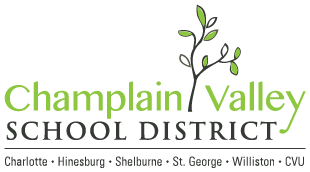Personalized learning in the Champlain Valley School District
 This week’s CVSD board meeting featured a discussion of personalized learning, which is designed to maximize student choices around curricula and respond to individual learning styles. It is an important building block in the Proficiency Based Learning (PBL) system that the Champlain Valley School District has embraced across all schools.
This week’s CVSD board meeting featured a discussion of personalized learning, which is designed to maximize student choices around curricula and respond to individual learning styles. It is an important building block in the Proficiency Based Learning (PBL) system that the Champlain Valley School District has embraced across all schools.
The rationale for moving to PBL is to achieve more involvement by students in their education. In addition to mastering the curriculum, students are encouraged to understand themselves as learners. They are urged to take an active role in designing their own educational program.
Much of the board’s discussion of the meeting focused on the CVU Nexus Program. Nexus involves students selecting a topic of interest, designing learning activities that connect to CVU standards and proceeding to gather school and community resources to complete the projects. The goal is to personalize learning. The program seeks to combine several disciplines in one project, encourage inquiry and encourage student self-reflection. Some examples of projects discussed included creating and developing robotics, constructing a tiny house and exploring the biology of local ponds.
Questions raised by board members about Nexus included the connection between the projects and the curricular standards and other accountability issues. Are such projects connected to the curricular standards that all students must acquire? Across the country the most successful states and districts implementing Proficiency Based Learning programs have tied personalized learning closely to academic standards. Otherwise students find themselves in a sea of interesting topics that may not be connected to graduation standards.
Nationally, several states have undertaken initiatives to move toward Proficiency Based Learning. Some have seen a successful transition to this more individualized system. Others have faltered because of efforts required to translate curricular standards into several different options for student choice.
Once the curriculum has been translated into different learning tasks related to curricular standards, the difficult next steps require establishing goals for habits of learning that will be integrated into all courses and projects. These habits of mind and learning have been defined by CVU as Think, Live, Learn, Contribute and Pursue Excellence. Significant work has been done to describe how these are broken down into learning goals.
The Champlain Valley School District is building on 20 years of experience establishing curricular standards and instituting desirable habits of learning through successive national and state reforms. Prior to education reform initiatives begun in the 1980s, local schools created their own learning goals. As a result, students across the country varied in performance and fared more poorly than students in other industrialized countries. Waves of reform over the past 30 years have focused on several areas: school leadership and structure, curricula rigor and alignment, increased accountability and standards, academic and parental support, professional development for teachers and re-designing high schools.
Many states have raised the bar of student achievement through these measures, but an achievement gap persists among students from low-income homes. And high schools in particular have been plagued by problems relating to attendance, persistence and, in Vermont, transition to post–secondary education. Vermont has one of the highest rates of high school graduation in the country but one of the lowest rates of post-secondary enrollment after high school.
The move to personalize education through Proficiency Based Learning and personalization seeks to close that gap so that all students may find a school environment that encourages them to build a stronger sense of themselves as learners and to continue as life-long learners after graduation.
Nancy Richardson served as a policy analyst for the U.S. Department of Education, chief education advisor to the governor of Massachusetts and director of planning for the Vermont State College system. She lives in Charlotte.

